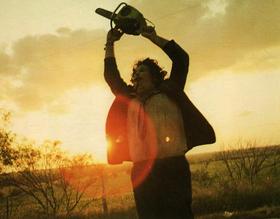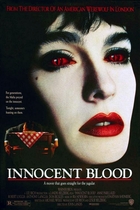Our editor-in-chief Nate Yapp is proud to have contributed to the new book Hidden Horror: A Celebration of 101 Underrated and Overlooked Fright Flicks, edited by Aaron Christensen. Another contributors include Anthony Timpone, B.J. Colangelo, Dave Alexander, Classic-Horror.com's own Robert C. Ring and John W. Bowen. Pick up a copy today from Amazon.com!
Texas Chainsaw Massacre Month (October 2010)
It began, legend says, at Christmas time. Tobe Hooper, a film director whose only feature credit had been a hippie drama called Eggshells, was standing in a Montgomery Ward, trapped by the bustle of last-minute shoppers. As he contemplated how to get through the mass of consumerism, he found violent inspiration in a display of chainsaws.1 Thankfully, he didn't act on his carnage-filled fantasy of bloody crowd control. Instead, he channeled the idea into his second feature, a low-budget horror flick about a quintet of young people who are beset by a family of cannibal hicks in the sweltering Texas summer. Although produced with working titles such as Headcheese and Leatherface, it was released in 1974 with the only name it would ever need: The Texas Chain Saw Massacre. This brutal cacophony of terror would go on to spawn three direct sequels, documentaries, a video game, several comic books, an official fan club, and countless pieces of collectible merchandise. Its imitators are innumerable. In 2003, New Line Cinema and Platinum Dunes released a remake which spawned its own prequel, merchandise, and comic books.
Why does this movie, of all the low-budget regionally-specific horror movies made in the 1970s, resonate? The explanation, I feel is as simple as it can be: Hooper and his motley film crew set forth to make a movie that works its way into your brain and never lets go. They succeeded completely. Although it is often lumped in with the slasher movie, which was just getting its start in 1974, The Texas Chain Saw Massacre is in many ways antithetical to the carefully orchestrated series of silences and screams, not to mention the moral determinism, of Halloween and its ilk. From the upturned armadillo in the first scene to Sally Hardesty's blood-soaked hysteria in the last, The Texas Chain Saw Massacre depicts a world of noise and chaos, sound and fury that signifies (with apologies to Mr. Shakespeare) everything. It's unlike any another film ever made, even (or especially) the films that slavishly try to replicate its successes.
The tenaciousness of the hold that Hooper's film has on horror fans can still surprise. When I proposed doing a Texas Chainsaw2 event to the staff, I figured that I would get one or two article proposals to supplement the four reviews and two interviews I already had lined up. We'd fill up the last week of October and that would be it. I wasn't prepared for the staff's response at all. A total of seven features were proposed, along with an additional review. Not only would we run a post a day in the seven days leading up to Halloween, but we would post an additional TCM-related feature every Friday of the month. Each proposal had a different take, from a look at the film's fate at the hands of British censors to an exploration of the media's fascination with serial killer Ed Gein, who was the inspiration for Leatherface.
Alongside the features, our regular Monday review slot will be occupied by the three Texas Chainsaw Massacre sequels (and the unofficial Gein biopic Deranged), all leading up to Robert Ring's review of the original film on Sunday, October 31st. We'll also have interviews with star Marilyn Burns and musician Roger Bartlett, who wrote the song "Fool for a Blond" which appears on the soundtrack.
This is one of the most exciting events we've ever run on Classic-Horror.com, and as the month goes on, I think you'll agree.
Reviews
Features
- Shiverin' 6: Meet the Sawyers
- Ed Gein: Pop Star
- Roger Bartlett ("Texas Chain Saw Massacre" musician) Interview
- The Texas Chain Saw Massacre: Revenge of the Silent Majority
- Oil and a Dangerous South: Alternate Geopolitical Readings of "The Texas Chain Saw Massacre"
- The Goriest Film You Never Saw
- TCSM vs. the BBFC
- Marilyn Burns ("Texas Chain Saw Massacre") Interview
- Texas Chainsaw Video Jukebox









This ought to be good. TCM is
This ought to be good. TCM is one of the best and scariest horror films ever.
You've always been the caretaker.
The remake of Texas Chainsaw
The remake of Texas Chainsaw Massacre was pretty good. They don't make old time slasher movies like they used, too. Hunger and Road Kill from the new Fangoria FrightFest movies are pretty good, though.
I can remember the first time
I can remember the first time I saw TCM, it was re-released sometime in the late 70's and my Mother and I went to a cinema and watched this on the big screen. I can remember being shook up quite a bit, seeing its raw, visceral violence and I am not embarrassed one bit by saying at age of 15 being completely shocked by this film.
I caught my Mother a few times turning away from viewing the screen, it's safe to say, she hadn't experienced anything as graphic as TCM in her lifetime either.
TCM is a film I will never forget, since it was a movie that traumatized me and made me lose some sleep that evening..
Great Film!